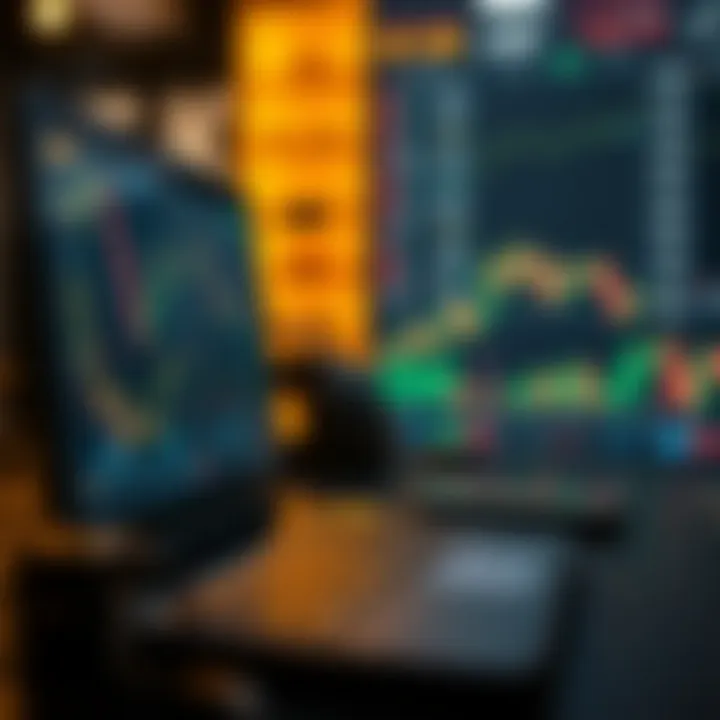Mastering Binance Advanced Trade: A Complete Guide


Intro
In the ever-evolving landscape of cryptocurrency, the Binance exchange stands as a prominent player, fervently pushing the boundaries of trading possibilities. For those who have dipped their toes into this vast ocean of digital assets, navigating through Binance is akin to steering a ship through tumultuous waters. However, with the right tools and knowledge, one can sail smoothly.
Binance Advanced Trade offers a suite of sophisticated features designed for traders who want to take their skills to the next level. It goes beyond basic trading by providing users with advanced analytics, a plethora of trading pairs, and customizable tools that can give any trader a significant edge. Understanding how to utilize these features effectively is crucial for making informed trading decisions and managing risks wisely.
In this guide, we will delve into various facets of Binance Advanced Trade. From unpacking the latest trends in the cryptocurrency markets to exploring innovations in blockchain technology that are reshaping the industry, the aim here is to equip you with the tools necessary to become a more competent trader.
So, whether you're a novice eager to learn the ropes or a seasoned pro looking to refine your strategy, stick around. The journey through Binance Advanced Trade promises a wealth of insight and actionable strategies. Let’s get started.
Preface to Binance Advanced Trade
In the ever-evolving world of cryptocurrency, understanding the intricate dynamics of trading platforms is essential for both novice and seasoned investors. This section aims to shed light on Binance Advanced Trade and its significance within the broader context of cryptocurrency trading. By diving deeper into its features, tools, and advantages, we prepare you for an enlightening journey into this powerful trading platform.
Overview of Binance
Binance has established itself as one of the leading cryptocurrency exchanges since its inception in 2017. What started as a simple platform for buying and selling cryptocurrencies has blossomed into a multifaceted ecosystem designed for traders of all levels. The sheer volume of transactions and the variety of assets available on Binance are staggering. With over 600 cryptocurrencies for trading, users have a vast selection at their fingertips. This high liquidity, combined with a robust security framework, makes Binance an attractive destination for those looking to delve deeper into cryptocurrency investments.
Furthermore, Binance consistently evolves to meet the changing needs of traders. Frequent updates and the introduction of new features showcase their adaptability. The platform's user interface is designed to navigate seamlessly, whether for casual buying or intricate trading strategies.
Defining Advanced Trade Features
When we talk about advanced trading on Binance, we are looking at a suite of tools designed to give traders more control and insights into their investments. These features include:
- Multiple Order Types: Unlike simple buy or sell orders, Binance allows for complex order types like limit orders, stop-limit orders, and trailing stops, giving traders flexibility and strategic options.
- Advanced Charting Tools: Traders can utilize sophisticated technical indicators and charting options to analyze price motions effectively, capturing intra-day shifts and long-term trends with precision.
- APIs for Automation: For those who prefer automated trading, Binance offers robust APIs that allow users to implement trading bots to execute predefined strategies without manual intervention.
In essence, the advanced trading features empower users, providing the necessary instruments to navigate the volatile landscape of cryptocurrency trading with confidence. Understanding how to leverage these tools effectively can be the difference between a mediocre trading experience and one that leads to significant profit.
Understanding the User Interface
The user interface (UI) serves as the digital doorway into the Binance Advanced Trade platform. A well-designed UI is paramount for facilitating a seamless trading experience, particularly in a market as volatile and fast-paced as cryptocurrency. Understanding this interface not only makes one adept with the platform's tools but also plays a crucial role in executing trades efficiently. Familiarizing oneself with the UI can amplify the effectiveness of your trading strategies while minimizing the anxiety that often accompanies market engagement.
Navigating the Dashboard
Navigating the dashboard is your first step into the Binance Advanced Trading realm. The dashboard presents a plethora of information at a glance. When you first log in, you’re greeted with real-time price charts, your portfolio summary, and available trading pairs. Remember, it can be overwhelming at first glance, but it really holds a wealth of knowledge.
- Price Charts: The charts are often the heart of the dashboard. You can flip between different time frames, such as hourly, daily, or weekly, to analyze price movement. Each chart often tracks the volatility of selected cryptocurrency pairs, which is crucial for anticipating market trends.
- Order Book: This displays the active buy and sell orders on the platform, sorted by price. Understanding how to interpret the order book can give insights into market sentiment and potential price movements.
- Portfolio Overview: Your portfolio will reflect what assets you hold and their current values. It’s your financial report card, essentially. Keeping an eye on this will help reinforce your risk management practices while revealing areas for adjustment in your trading strategy.
- Settings and Alerts: You can set custom alerts based on price levels. This feature ensures you’re not glued to your screen all day yet still stay updated on essential price movements.


In summary, practicing navigation through the dashboard is akin to learning the layout of a new city. You may fumble around initially, but with time, you’ll start recognizing familiar landmarks and paths.
Customizing Your Trading View
After getting comfy navigating the dashboard, the next step is to customize your trading view. The beauty of the Binance platform lies in its adaptability; you can tailor it to suit your trading style and preferences.
- Adjusting Chart Types: You can choose between various chart types like candlestick, line, or bar charts. Each offers unique insights. For example, candlestick charts are excellent for understanding market psychology.
- Adding Indicators: Incorporate technical indicators like moving averages or RSI to supplement your analysis. They can help illuminate potential trading signals, adding an extra layer of insight to your decision-making.
- Layout Preferences: Want to see multiple charts at once? The layout can be adjusted to show several assets side by side. This feature is advantageous for day traders needing to monitor multiple pairs simultaneously.
- Color Schemes: Some traders find certain color schemes easier on the eyes than others, especially during long hours of trading. Changing colors can reduce strain and help maintain focus.
By customizing your trading view, you’re not just making the interface aesthetically pleasing; you’re also enhancing your capability to make well-informed trading decisions. It’s about setting the stage to play your best game.
"The interface is like any well-fitted suit; it complements your skills and allows you to shine in your performance."
Trading Types Available on Binance
In the crypto marketplace, choosing the right trading type is akin to picking the right tool for the job. For investors navigating the advanced trading offerings of Binance, understanding the various trading types can significantly impact one's ability to optimize returns and manage risks effectively. Each trading type available on Binance has its own set of features, risks, and potential rewards, necessitating a comprehensive knowledge base for traders at all levels.
When considering trading types, investors should weigh several factors: market volatility, personal risk tolerance, and financial goals. The dynamic nature of cryptocurrencies means that trading types are not just strategic choices; they are integral elements of a trader's overall approach to capturing market movements. Let's delve into the specifics of the trading types Binance provides.
Spot Trading
Spot trading is often the first port of call for traders new to the crypto scene. Here, users buy or sell cryptocurrencies for immediate delivery based on current market prices. This form of trading is simple and straightforward, making it ideal for beginners.
The appeal lies in the transparency and immediacy of transactions. Users can see real-time prices and place orders that match these prices quickly. Additionally, spot trading enables users to hold their assets directly, giving a sense of ownership that derivatives do not offer.
One key consideration in spot trading is liquidity. High liquidity often results in better prices, reducing slippage for large orders. Traders should pay attention to the volume of trades and the activity on the trading pairs they wish to pursue. When liquidity is robust, entering and exiting trades becomes smoother, making spot trading an effective option for both day traders and long-term holders.
Margin Trading
Margin trading takes the possibilities of trading a step further. It allows traders to borrow funds to increase exposure and potential returns. This means that, while an investor may only have a small amount of capital, they can control larger positions by using leveraged funds.
However, this technique carries higher risks. While margin trading can amplify profits, it can also magnify losses. Traders need to monitor their positions carefully and understand the liquidation risks involved. Thus, sound risk management strategies are critical. Consequently, trading on margin is likely best left to those with some prior experience in trading.
A useful element of margin trading on Binance is the margin call feature, alerting traders when their equity falls below the required maintenance margin. This further emphasizes the responsibility traders have in managing their positions effectively, ensuring they act before potential liquidation occurs.
Futures and Options Trading
Futures and options trading represents a more complex strategy layer. In futures trading, contracts are entered into agreeing to buy or sell an asset at a predetermined price at a specific point in the future. This enables investors to speculate on the future price movements of cryptocurrencies while not needing to hold the underlying assets directly. Due to this structure, futures trading can offer significant benefits for hedging positions or making educated predictions about market directions.


Options trading, on the other hand, gives traders the right, but not the obligation, to buy or sell a cryptocurrency at a set price before a specified date. The flexibility inherent in options allows investors to create various strategies depending on their market outlook.
Both of these trading types can be quite sophisticated and carry their own risks, and thus are often more suitable for seasoned traders. They allow for greater profit potential but require a good grasp of market dynamics and strategic planning.
In summary, understanding the different types of trading available on Binance can significantly impact trading success. Rather than taking one-size-fits-all strategies, traders should consider their individual preferences and market conditions when choosing.
Advanced Trading Tools
In the unpredictable world of cryptocurrency, having the right tools can make a significant difference in a trader's success. Advanced trading tools empower users to strategize and execute trades more effectively. They offer features that go beyond the simple buy and sell options found on basic trading platforms. By utilizing these tools, traders can adapt to market fluctuations, manage risks better, and seize opportunities promptly.
The significance of advanced trading tools lies in their ability to automate aspects of trading and enhance decision making. These tools can provide analytical insights, market data patterns, and various order types to streamline the trading process. A lack of familiarity with these features could lead to missed opportunities or undesirable outcomes.
Limit and Market Orders
Limit and market orders are fundamental components of trading on Binance. A market order is executed immediately at the current market price. This is excellent for those who want to act swiftly but can come with the caveat of slippage, where the final execution price may differ from the expected one. Conversely, a limit order allows traders to specify the price at which they want to buy or sell. This provides greater control but might lead to missed chances if the market doesn't reach that price.
- Benefits of Limit Orders:
- Drawbacks of Market Orders:
- Precision in execution at desired price points.
- Reduced emotional trading, as traders plan their entry and exit ahead of time.
- Potential for poor execution during volatile market conditions.
- Higher chances of slippage.
Utilizing these order types appropriately can make all the difference, especially when market conditions are irregular.
Stop-Limit Orders
A stop-limit order combines elements of both stop orders and limit orders, thereby giving traders added flexibility. It is set using two price levels: the stop price and the limit price. When the market reaches the stop price, the stop-limit order transforms into a limit order and is then executed at the limit price or better.
This tool is notably useful for protecting profits or minimizing losses as it allows traders to set predefined points to act automatically, eliminating emotional responses that can lead to irrational decisions.
- Key Advantages:
- Predefined risk management: It ensures that traders know the worst-case scenario before entering a trade.
- Automates exit strategies: Once the criteria are met, the order acts without manual intervention.
However, it requires a good understanding of the market conditions to set the stop and limit price effectively, as improper settings may lead to missed opportunities or unnecessary trades.
Trailing Stop Orders


A trailing stop order further aids in optimizing profit and managing risk. It allows traders to set a specific percentage or dollar amount away from the market price, and as the price moves favorably, the stop order rises or falls accordingly, following the momentum of the trade.
This tool is especially favored by those who need a hands-off approach while still capitalizing on market swings. Unlike static stop orders, trailing stops dynamically adjust, which means they can aid traders in capturing profits on upward trends while mitigating losses on reversals.
Considerations for Using Trailing Stops:
- Be mindful of volatility: In extremely volatile conditions, the price fluctuations may trigger the trailing stop even when the overall trend remains favorable.
- Set reasonable trailing distances: Too tight a trailing distance may lead to premature exit, whereas too loose may expose one to downtrends.
In summary, utilizing advanced trading tools can greatly enhance a trader's experience on Binance. Understanding and implementing limit and market orders, stop-limit orders, and trailing stop orders are just a few examples of how traders can better navigate the turbulent waters of cryptocurrency trading.
Risk Management Strategies
When it comes to trading, the landscape can be as unpredictable as a rollercoaster – thrilling for sure, but definitely not for the faint-hearted. That's where risk management strategies play a pivotal role in keeping your investments as safe as a house in winter. Understanding how to navigate these strategies can mean the difference between staying afloat and sinking fast in the tumultuous sea of cryptocurrency trading.
In this section, we will explore several crucial components of risk management, focusing on methods and practices to help mitigate potential losses while maximizing gains. These practices are essential for both novice and experienced traders as they aim to maintain a sustainable trading approach without letting fear dictate their strategies.
Setting Stop Loss and Take Profit Levels
Establishing stop loss and take profit orders is akin to setting up guardrails on a dangerous cliff. A stop loss is an order placed to sell a security when it reaches a certain price, effectively limiting potential losses. Conversely, a take profit order ensures that your investment is automatically sold once it hits a lucrative price, securing your profits before market reversals begin.
To illustrate, if you purchase a Bitcoin at $30,000 and you set a stop loss at $28,000, your position will automatically close when Bitcoin hits that price. This provides peace of mind, knowing that your exposure is capped. Similarly, a take profit set at $35,000 ensures that you snag that profit without watching the market too closely.
Diversification Techniques
"Don't put all your eggs in one basket," is an age-old saying that rings particularly true in the world of investing. Diversification is all about spreading your investments across various cryptocurrencies and asset classes. It’s like seasoning a dish; a little variety enhances the overall flavor.
Investing in multiple digital assets can minimize your exposure to any single asset’s volatility. For instance, if you're holding Bitcoin, consider allocating a portion of your portfolio to Ethereum or Cardano. This way, if one asset takes a dive, others might be swimming against the current.
Here are some effective diversification strategies:
- Invest in different sectors: Look into projects that span various sectors, such as DeFi (Decentralized Finance), NFTs (Non-Fungible Tokens), or blockchain solutions.
- Include non-correlated assets: Assets that do not move in tandem can help buffer against market dips.
- Consider stablecoins: Holding some funds in stablecoins like USDC can provide a balance during high volatility.
Proper Position Sizing
Position sizing is not just about how much to invest but also about how much you can afford to lose without sweating bullets. It involves determining the correct amount of capital to allocate to each trade based on your risk tolerance and the specific dynamics of that asset. A common guideline is the 1% rule, which suggests risking no more than 1% of your total trading capital on a single trade.
For example, if your trading account holds $10,000, the maximum amount you should risk per trade would be $100. This careful approach prevents catastrophic losses from a single bad trade and cushions your portfolio from severe hits.
Utilizing formulas or tools to calculate position size can also be beneficial. Here’s a quick formula for clarity:
plaintext Position Size = (Account Risk Amount) / (Trade Risk per Share)







